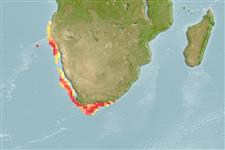Classification / Names
ชื่อสามัญ | ชื่อพ้อง | Catalog of Fishes(สกุล, ชนิด) | ITIS | CoL | WoRMS | Cloffa
sub class Elasmobranchii (ฉลามและกระเบน) (sharks and rays) >
Rajiformes (Skates and rays) >
Gurgesiellidae (Pygmy skates)
Etymology: Cruriraja: Latin, crur, cruris = pertaining to a leg + Latin, raja = a ray (Raja sp) (Ref. 45335); hulleyi: Named for P.A. ‘‘Butch’’ Hulley, for his pioneering research on southern African skates..
Environment: milieu / climate zone / depth range / distribution range
นิเวศวิทยา
เกี่ยวกับทะเล,น้ำเค็ม กลุ่มสัตว์หน้าดิน,กลุ่มสัตว์พื้นท้องน้ำ; ระดับความลึก 39 - 545 m (Ref. 85323), usually 200 - 500 m (Ref. 85323). Subtropical
Southeast Atlantic: Lüderitz, Namibia to Algoa (and possibly East London) on the Eastern Cape coast of South Africa.
ขนาด / น้ำหนัก / Age
Maturity: Lm ? range ? - ? cm
Max length : 58.0 cm TL เพศผู้/กระเทย; (Ref. 85323); 59.4 cm TL (female)
Short description
สัณฐานวิทยา | ความยาวต่างๆ
This species is distinct from its congeners in having the following characters: spatulate distal ends of the anterior pelvic lobes (wider tip in C. cadenati, tapering in others); dorsal mid-disk and tail with continuous semiparallel rows of thorns in adults (no thorns on mid-disk in C. rugosa, present on midline in others); claspers with small, flattened process (boss) on accessory terminal 2 cartilage and blind-ended sac with posterior opening at the distal end of the clasper (sentina), both unique within genus to C. hulleyi; interdorsal thorns 6 (none in C. durbanensis, 2 in C. parcomaculata, 4 in C. poeyi, 1 in C. rugosa, many in C. atlantis). This species is further distinguished from its congeners by the following set of characters: interdorsal distance greater than half, and not exceeding, dorsal-fin base length (vs. at least 1.5 times dorsal-fin base length in C. atlantis, half or less dorsal-fin base length in C. parcomaculata); outer lateral margin of clasper dorsal marginal cartilage elongated and bluntly rounded (truncate in C. rugosa); proximal margin of dorsal terminal I cartilage forms a point (a series of points in C. rugosa); distal point (eperon) of ventral terminal cartilage relatively narrow and claw-like (bifurcate in C. parcomaculata, expanded in C. rugosa); ventral surface of clasper without dermal denticles (present in C. parcomaculata) (Ref. .85323).
Reported to be a moderately common species of the outer shelf and upper continental slope, 39-545 m deep, but most common between 200 and 500 depth. Larger individuals tend to occur on the west coast of southern Africa, while those on the south coast are slightly smaller. The egg case was described to be small, vase-like, measuring less than 50 mm long excluding horns, surface coarsely striated, and with very narrow lateral keels, <1% of maximum egg case width; its posterior horns are approximately 45% longer than the anterior horns, tapering to thin tips, curving inwards and with fine attachment fibers; the anterior horns are hook-shaped, with acute tips (Ref. 85323).
Life cycle and mating behavior
วัยเจริญพันธุ์ | การสืบพันธุ์ | การวางไข่ | เซลสืบพันธ์ของเพศเมีย(ไข่) | ความดกของไข่ | ตัวอ่อน
Aschliman, N.C., D.A. Ebert and L.J.V. Compagno, 2010. A new legskate (Rajoidei: Genus Cruriraja) from Southern Africa. Copeia 2010(3):364-372. (Ref. 85323)
IUCN Red List Status (Ref. 130435)
Threat to humans
Harmless
Human uses
ข้อมูลเพิ่มเติม
ชื่อสามัญชื่อพ้องกลไกการเผาผลาญพลังงานผู้ล่าการศึกษาเกี่ยวกับผลกระทบของสารประกอบทางเคมีที่เป็นอันตรายต่อสิ่งมีชีวิต ประชากร และสิ่งแวดล้อมการสืบพันธุ์วัยเจริญพันธุ์การวางไข่การรวมกลุ่มวางไข่ความดกของไข่เซลสืบพันธ์ของเพศเมีย(ไข่)Egg development
Age/SizeการเจริญเติบโตLength-weightLength-lengthLength-frequenciesความยาวต่างๆสัณฐานวิทยาตัวอ่อนพลวัตของสัตว์น้ำวัยอ่อนการทดแทนที่อุดมสมบรูณ์BRUVS
อ้างอิงการเพาะเลี้ยงสัตว์น้ำประวัติการเพาะเลี้ยงสัตว์น้ำสายพันธุ์พันธุศาสตร์ElectrophoresesอัตราพันธุกรรมโรคการแปรรูปNutrientsMass conversion
ผู้ร่วมมือรูปภาพหลายรูปStamps, Coins Misc.เสียงปลามีพิษ เช่น ปลาปักเป้าความเร็วรูปแบบการว่ายน้ำพื้นที่เหงือกOtolithsสมองวิสัยทัศน์
เครื่องมือ
Special reports
Download XML
แหล่งที่มาจากอินเตอร์เน็ต
Estimates based on models
Preferred temperature (Ref.
123201): 6.7 - 14, mean 9.5 °C (based on 54 cells).
Phylogenetic diversity index (Ref.
82804): PD
50 = 0.5039 [Uniqueness, from 0.5 = low to 2.0 = high].
Bayesian length-weight: a=0.00661 (0.00225 - 0.01943), b=2.95 (2.71 - 3.19), in cm total length, based on LWR estimates for this (Sub)family-body shape (Ref.
93245).
ระดับชั้นอาหาร (Ref.
69278): 3.9 ±0.6 se; based on size and trophs of closest relatives
Fishing Vulnerability (Ref.
59153): Moderate vulnerability (44 of 100).
